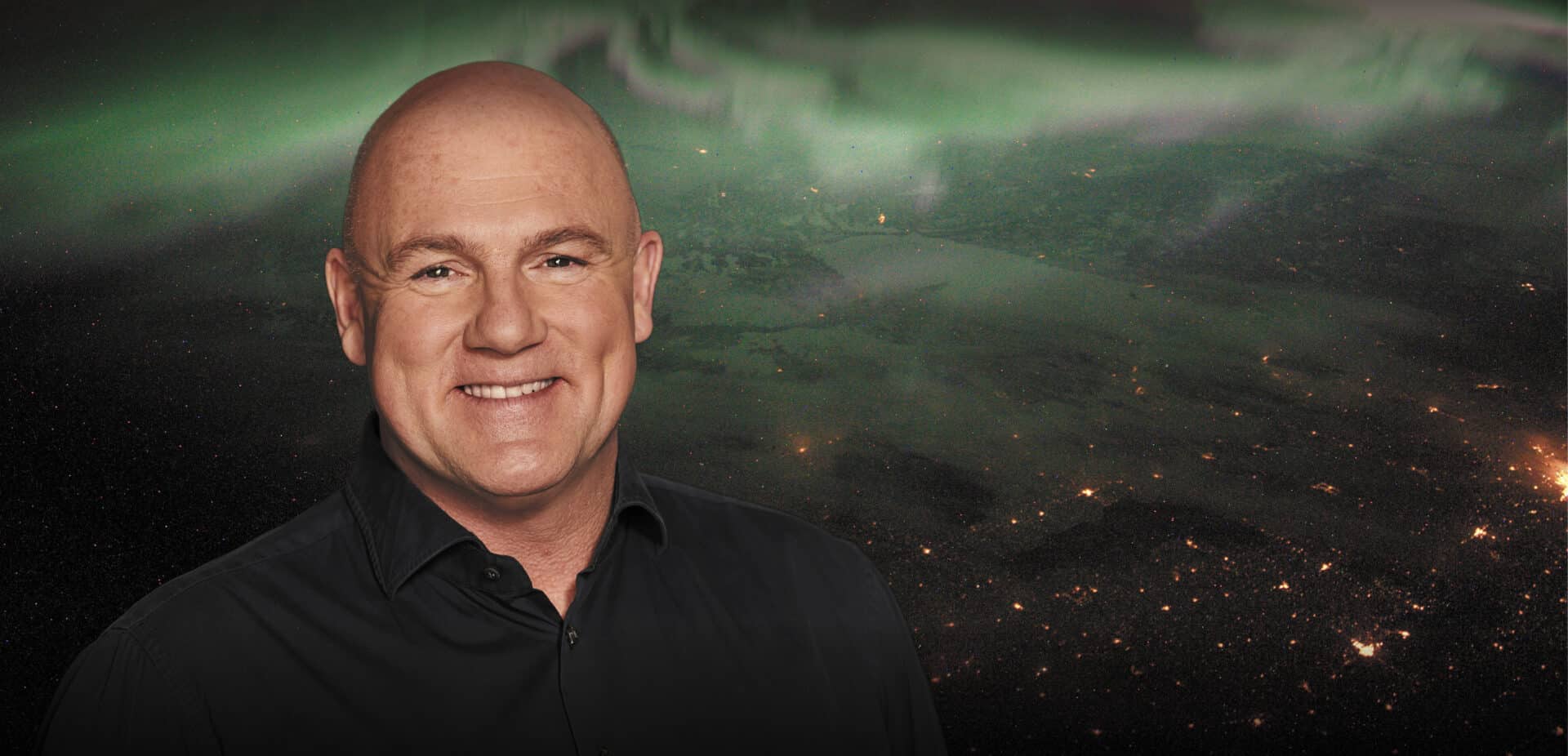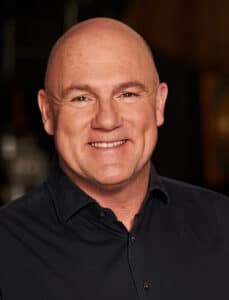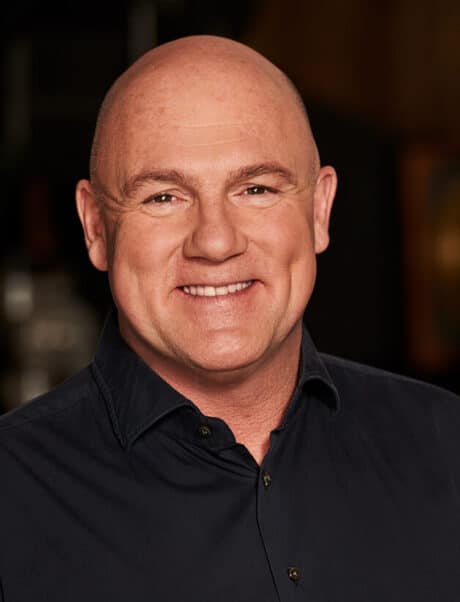

Space travel is the tool of the future
Space travel will frequently dominate the news in the upcoming years. The moon will be visited again, this time to stay. Space tourism for the wealthy will get a boost and if the film industry has its way, the International Space Station ISS will even become the setting for feature films

André Kuipers
Astronaut and Ambassador of the EarthMeanwhile, a new space race is emerging between two geopolitical power blocs, commercial companies are taking over traditional tasks from space agencies, tech giants like SpaceX and Amazon are putting tens of thousands of satellites into orbit. Samples from Mars are also being flown to Earth for the first time in history, and we are diligently seeking solutions to the ever-growing problem of space debris. Better than ever, we are able to monitor our own planet. „Earth observation is indispensable to make the right decisions for the future of our planet,“ explains André Kuipers in conversation with Speakers Academy Magazine.
It seems like space exploration has been in the news more and more recently. Is this observation correct?
„In recent years it seemed like very little exciting was happening. Since 2011, the U.S. Space Shuttle had been on the ground. All manned flights were performed exclusively by the Russian Soyuz. And although spectacular, a Soyuz launch does not cause much of a stir when you know that these rockets have been used since the late 1960s. It rarely goes wrong. On average, we launched about a dozen astronauts each year from America, Russia, Europe and Japan and a few smaller countries. China conducted its own space program. Of course, that didn’t sit well with the Americans. They have worked very hard for the past ten years to be able to launch from their own soil again.“
Why did the scoop of a launch from American soil go to the commercial company SpaceX?
„NASA had commissioned two companies to develop a new launch system: Boeing and SpaceX. For a long time it looked like Boeing would be the first to launch with the Starliner, but an unmanned test flight failed. As a company, you soon fall behind, because first you have to find out exactly what went wrong and why. In manned space flight, the safety requirements are extremely high. This presented opportunities for Elon Musk’s SpaceX, a company that is extremely adept at marketing. Just think of launching the Tesla, who would come up with something like that? SpaceX managed to reach a huge audience for the launch of its first manned test flight. Online, it was NASA’s best watched launch ever. I too was glued to the screen.“
Seeing the world from a distance gives a good perspective on the challenges we face.
How did you view the launch of this new spacecraft from SpaceX?
„SpaceX is a special company. I had the honor of docking the first Dragon cargo ship to the ISS in 2012. That was a historical moment, as it was the first time a commercial company sent a vehicle to the ISS. At SpaceX in California where I trained, I saw that young people are given a lot of responsibility. That’s crucial. Young people don’t think in terms of problems, but in terms of possibilities. Moreover, SpaceX develops a lot of things in-house and uses existing products from the market. It enables the company to implement new technology quickly and keep on going, thus creating a lead on competitors that is almost impossible to catch up with.“
Boeing is also eagerly anticipating its Starliner?
„I am looking forward with interest to the launch of the first staffed Starliner, as my friend and colleague Mike Fincke is on board. Mike and I flew our first flight together, in 2004. He invited me to the launch and I hope to witness this next step in the history of manned spaceflight. America will soon have access to two different systems. SpaceX’s Crew Dragon looks rather minimalistic with its touchscreens, the Starliner is more hybrid and has a combination of touchscreen and buttons. I believe I would feel a little safer with that one. Maybe that’s because I was trained on the Soyuz, a system that is very layered: from fully automatic to fully manual and analog.“
Why does NASA send its astronauts on commercial spacecraft?
„Boeing and SpaceX are paid for the missions NASA gives them and thus exist by the grace of taxpayer money. We call it ‚LEO‘ – spaceflight in orbit, in ‚low earth orbit‘ – we now have a good understanding of it. Little more needs to be discovered there, but there is still much efficiency to be achieved with new, smarter technology. At this stage it is up to the commercial parties. They can do it better, for less money. By the way, you see a big difference in approach between the different companies. SpaceX not only utilizes government money, but also enters the private market by selling seats to space tourists. Fifty million dollars for one seat not only brings in money, but also helps the company tremendously with marketing: putting SpaceX on the map as an über-cool company.“

When will the first space tourists leave for the ISS?
„What SpaceX is doing is nothing new. Between 2001 and 2009, seven private astronauts flew to the ISS. These were businessmen and a businesswoman who paid for their own Soyuz flight. Since the Space Shuttle was grounded, there were no free seats left and no tourists flew. Now that there is more room with new spacecraft, seats are being sold again. Also by the Russians. Japanese billionaire Yusaka Maezawa is expected to fly late this year. He is taking a Japanese cameraman with him to film his experiences, which can be followed via YouTube. This is not necessarily a novelty, because you can watch live what the astronauts – including Japanese – are doing anyway through NASA, but I can well imagine that his compatriots will find it fascinating, and this could be beneficial for public support for space travel in Japan.
In the first quarter of 2022, SpaceX, in partnership with the company Axiom, will launch the first three private space travelers from America, Canada and Israel. These passengers will prepare for their flight for about four months to learn the basic skills and not pose a danger to the professional crew. They prefer not to think of themselves as „tourists“ and will pay attention to a number of charities on board. One of them will be conducting experiments.“
We heard that Tom Cruise is also going to the International Space Station?
„In both America and Russia there are plans to send actors to the space station. The previous director of NASA believed that this would draw positive attention to space exploration and could create support for the activities of the agency, which is dependent on public money. Apparently, the thinking behind it is that an actor who pokes fun at doing the work of an astronaut is more interesting than the real work of the professionals. It may have given Russia the same idea, because there an actress has been selected in the role of a surgeon who has to rescue an astronaut in distress. This actress should be launched later this year, before Cruise at least. I believe there has been quite a bit of criticism on this plan, including from America, and it will not proceed for now. Whether the Russian side will agree to Cruise’s arrival is also not yet known. But if you ask me, sooner or later the ISS will serve as a backdrop in movies.
What is really going to cause a stir in the next five years?
„That is without a doubt our return to the moon. We’ve been there before, fifty years ago now, so you might think it’s not that complicated. But it is. A brand new rocket is being developed, the SLS. This mega-missile is even heavier than the Saturn V from the Apollo program. We go back to stay. There will also be a space station around the moon, Gateway. That means a lot of cargo has to be brought up there. That requires the most powerful rocket built to date. A new spacecraft, Orion, is also being developed for this purpose. The developments are now moving fast. America is cooperating with Europe, but China and Russia also share this ambition. Prestige and national pride, as in the 1960s, are beginning to play a role again. I hope that, in addition to a new space race, we will continue to cooperate in the areas of research and technology. There is still a lot unknown about the moon and we also need to work on good international laws and regulations.
After the moon, what is the next stop in space?
„That is without a doubt the Red Planet. It’s been the dream destination for decades, but humans on Mars, that’s really going to take some time. It’s an incredibly complex mission. To the moon we fly in three days, a return trip to Mars takes two and a half years. Throughout this mission, the crew must face many challenges: prolonged weightlessness, there must be sufficient food and water on board, and there is a lot of space radiation. Not to mention the conditions on Mars itself. You cannot breathe there, there is no liquid water, it is very cold (up to -140 degrees Celsius), there is a lot of radiation and there are severe dust storms. That there will be people on Mars is a given. We are anxiously awaiting the samples that, if all goes well, will be taken from Mars to Earth in 2031. It will be the first time we will have fresh material from Mars in our hands and we have no idea yet what it will yield. Science always makes us wonder.
Things are getting busier in space. What about space debris?
„That is an increasing problem, not for astronauts for whom a tiny piece of space debris can have fatal consequences. The speeds at which a collision can occur are enormous. We have seen that even a piece of paint can strike a pit in the window of the space station. Debris the size of a pea can puncture the ISS. This is another problem for which solutions must be found, because space around us is only getting more crowded. Amazon and SpaceX both want to send tens of thousands of satellites into space in the coming years to provide high-speed Internet to the far corners of this planet. A great ambition, but as you can imagine, it’s going to get incredibly crowded up there. Regulation is more important than ever to prevent the two systems from literally colliding.

Permanent monitoring of the Earth is taking place from space. What does this give us?
„Without realizing it, we are continually using space travel. Satellites in orbit make it possible for us to navigate and communicate, watch live games on television, predict the weather, measure air pollution, know how thick the ice is at the poles, and detect criminal acts, such as illegal logging, discharges and unlicensed fishing. And so I can go on and on.
An instrument like Tropomi, the Netherlands‘ pride in space because it is made in Holland, is worth its weight in gold. For example, the instrument observes the most important constituents of the atmosphere, including ozone, nitrogen dioxide, sulfur dioxide, carbon monoxide, methane, formaldehyde, aerosols, et cetera. Only in this way can scientists observe changes in climate and air quality. We need to know how the climate is evolving, how much the sea level is rising and the land is sinking, for example, especially in a low-lying country like ours. In addition, air pollution poses health risks. When you measure you know. When we know the origin of this pollution, we can take measures.“
What are we heading for in the coming years?
„Seeing the world from a distance gives a good perspective on the challenges we face. This is true for human eyes as well as for our electronic eyes that are permanently mapping the state of our planet. Earth observation – by man and machine – is an indispensable tool for making the right decisions for the future of our planet. The machine measures and the human adds value.
Humanity is capable of making innovations like Tropomi work for us. I believe that with our technology and science, we can identify and counteract causes and effects of climate change and pollution. The Netherlands Space Office (NSO) makes satellite data available for free through its satellite data portal, for scientists, entrepreneurs, but also for applications by the government itself. Hopefully this way, by looking at the world from a distance, we will get a grip on the problem.“
Source: ACADEMY Magazine 2021-2022 [Translated]

André Kuipers
Astronaut and Ambassador of the EarthAndré Kuipers is the first Dutchman with two space missions to his name. His second mission was...
Preisanfrage Profil ansehen